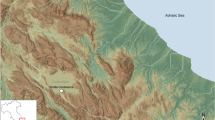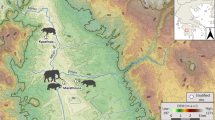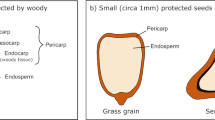Abstract
Hunter–Schreger bands (HSB) are seen in teeth that are composed of crossed sets of enamel prisms. They are present in the teeth of man and many other mammals1–6, but absent in most insectivores and multituberculates7–9. It has been suggested that the presence of HSB makes the tooth enamel less likely to split and is associated with chewing ability10. We have traced the occurrence of HSB back to the arctonic condylarths of the early Palaeocene (Puercan) age; this must be close to the first appearance of the bands in placental mammals. Our data indicate that the teeth of almost all large mammals since the early Palaeocene have contained these bands, in an orientation that is optimal for limiting the propagation of vertical fractures. The appearance of the bands is associated with the differentiation of herbivores and carnivores from insectivores and our data indicate that their development was critical to the diversification of mammals because it allowed the use of new types of foods.
This is a preview of subscription content, access via your institution
Access options
Subscribe to this journal
Receive 51 print issues and online access
$199.00 per year
only $3.90 per issue
Buy this article
- Purchase on Springer Link
- Instant access to full article PDF
Prices may be subject to local taxes which are calculated during checkout
Similar content being viewed by others
References
1. Kawai, N. Okijamas Fol. Anat. Jap. 27, 115–131 (1955). 2. Beier, K. Zoo/. Anz. 207, 288–299 (1981). 3. Tomes, J. Phil. Trans. R. Soc. Lond. 1850, 529–567 (1850). 4. Grine F. E. & Cruickshank, A. R. I. Proc. Electron Microscopy Sci. S. Africa 8,121–122 (1978). 5. Rensberger, J. M. & Koenigswald, W. v. Paleobiology 6, 447–495 (1980). 6. Brauer, R. Nova Acta Leopold. NF. Halle 13, 61–127 (1943). 7. Sahni, A. Palaeontographica 166, 37–49 (1979). 8. Fosse, G., Kieian-Jaworoska, Z. & Skaale, S. G. Paleontology 28, 435–449 (1985). 9. Carlson, S. J. & Krause, D. W. Contr. Mus. Paleont. Univ. Michigan 27, 1–50 (1985). 10. Koenigswald, W. v. Abh. senckenberg. naturforsch. Ges. Franfurt 539, 1–129 (1980). 11. Fortelius, M. Acta Zoo/. Fennica 180, 1–76 (1985). 12. Beier, C. Zoo/. Anz. Jena 210, 315–332 (1983). 13. Sahni, A. J. Paleont. Soc. India 25, 33–37 (1981). 14. Korvenkontio, V. A. Ann. Zoo/. Soc. Zool–Bot., Fennica Vanamo 2, 1–274 (1934). 15. Waters, N. E. Symp. Soc. Experiment. Biol. 34, 99–135 (1980). 16. Fliigge, W. Statik und Dynamik in Schalen (Springer, Berlin, 1981). 17. Powers, J. M., Craig, R. G. & Ludema, K. C. J. Dental Res. 52, 1327–1331 (1973). 18. Boyde, A. Operative Dent. 1, 13–28 (1976). 19. Hassan, R., Caputo, A. A. & Bunshah, R. F. J. Dental Res. 60, 820–827 (1981).
Author information
Authors and Affiliations
Rights and permissions
About this article
Cite this article
Koenigswald, W., Rensberger, J. & Pretzschner, H. Changes in the tooth enamel of early Paleocene mammals allowing increased diet diversity. Nature 328, 150–152 (1987). https://doi.org/10.1038/328150a0
Received:
Accepted:
Issue Date:
DOI: https://doi.org/10.1038/328150a0
This article is cited by
-
New Metatherian Mammal from the Early Eocene of Antarctica
Journal of Mammalian Evolution (2020)
-
Evolutionary and Functional Implications of Incisor Enamel Microstructure Diversity in Notoungulata (Placentalia, Mammalia)
Journal of Mammalian Evolution (2020)
-
Odontogenic ameloblast-associated (ODAM) is inactivated in toothless/enamelless placental mammals and toothed whales
BMC Evolutionary Biology (2019)
-
Crystallographic texture and mineral concentration quantification of developing and mature human incisal enamel
Scientific Reports (2018)
-
Mastication and enamel microstructure in Cambaytherium, a perissodactyl-like ungulate from the early Eocene of India
PalZ (2018)
Comments
By submitting a comment you agree to abide by our Terms and Community Guidelines. If you find something abusive or that does not comply with our terms or guidelines please flag it as inappropriate.



